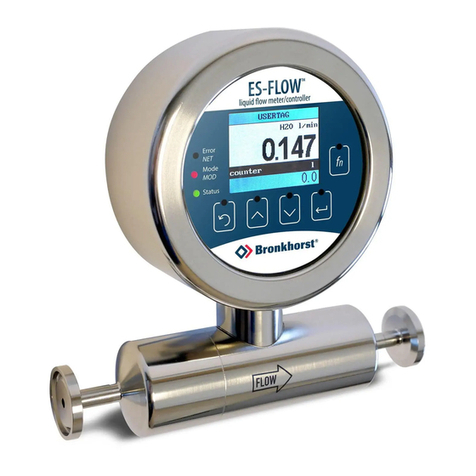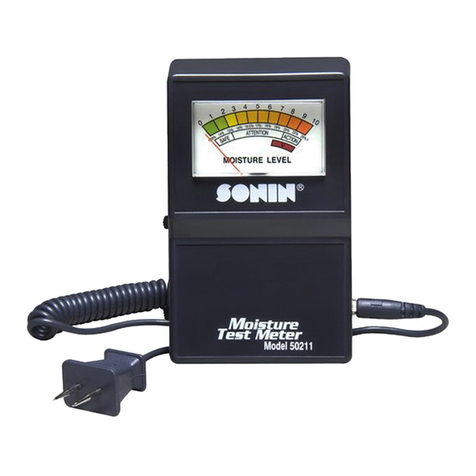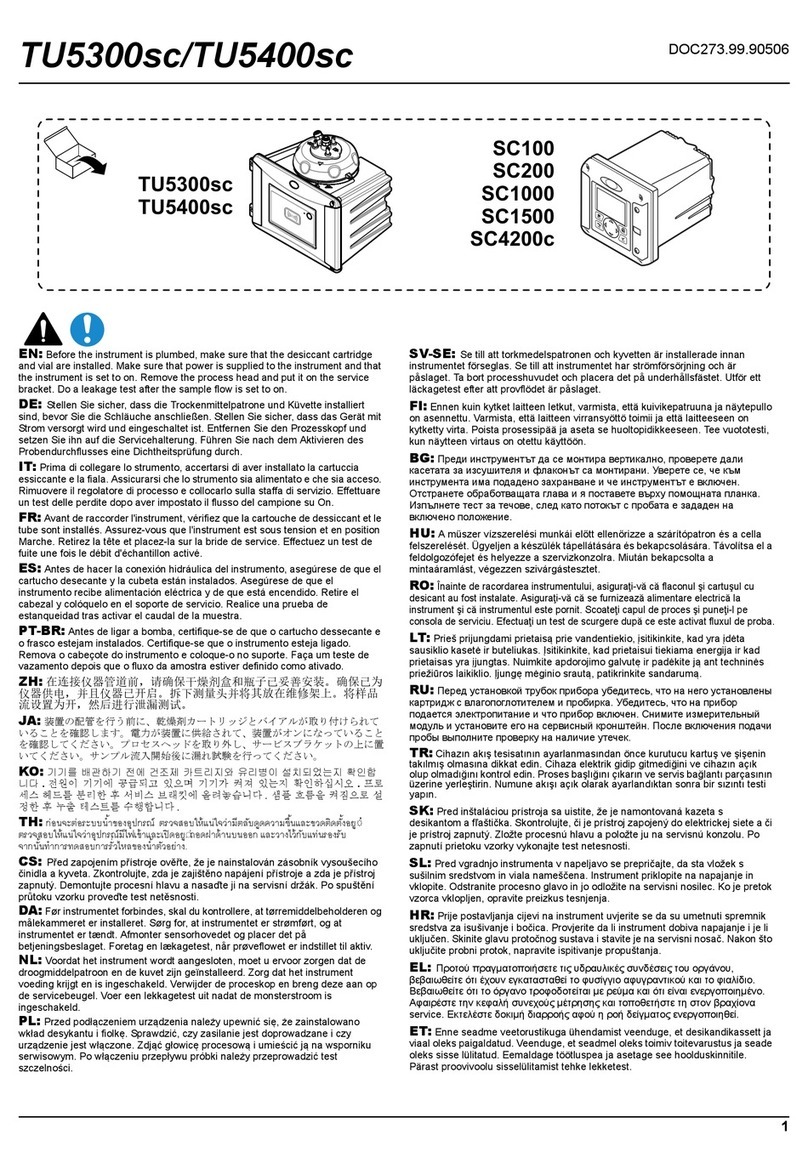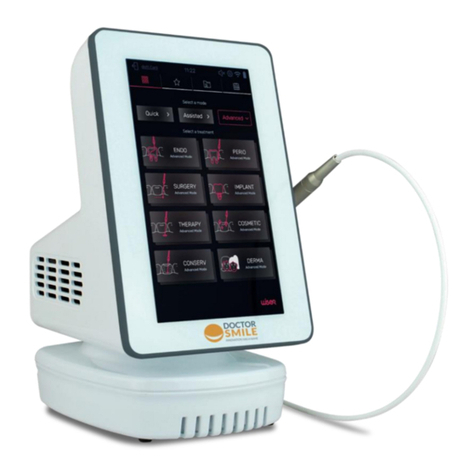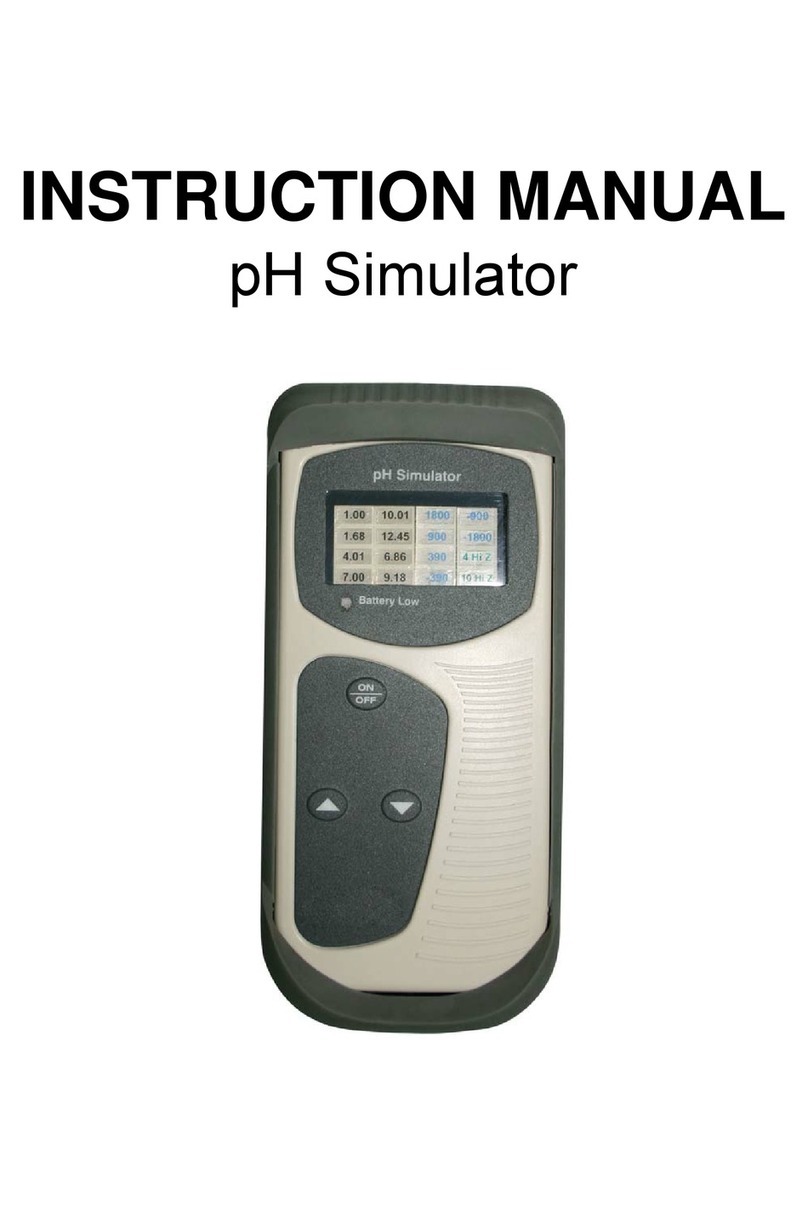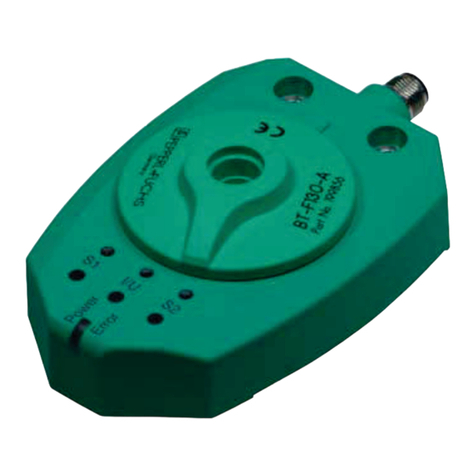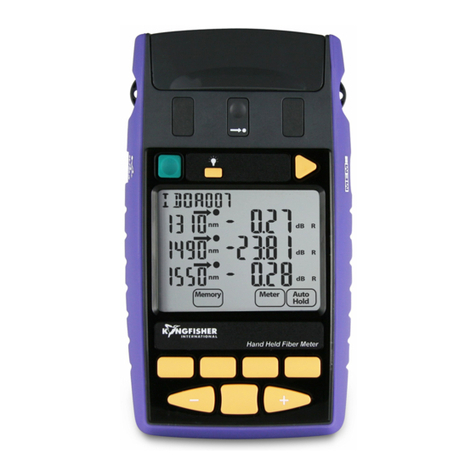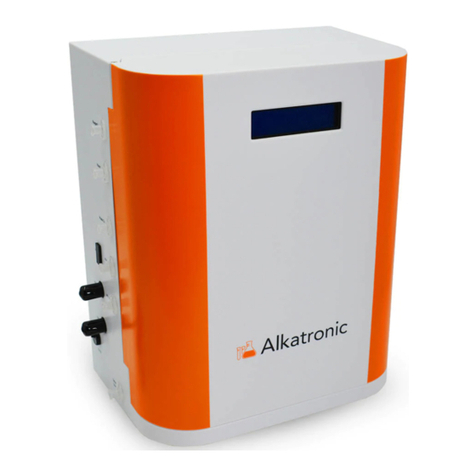vitro 120-E User manual

TABLE OF CONTENTS
Description Page
Specifications for 120-E Field Strength Meter 1
Tube Complement and Metering Crystals 1
Introduction 2
Description 2
Theory of Operation 3
1. Signal Input 5
2. RF Amplifier 5
3. First detector and oscillator 5
4. IF attenuator 5
5. First IF amplifier 5
6. Second IF amplifier 6
7. Third IF amplifier 6
8. Crystal rectifier 6
9. Calibrating oscillator 6
10. Switching system 6
Installation 6
1. Battery Installation 7
2. Use of external power supply 7
3. Use of recording equipment 7
Operation , 7
1. Checking battery voltages 7
2. Meter Calibration 8
3. Measuring signal strength 8
4. Operating procedure summary 9
5. Use of LOG -LIN switch 9
6. Turning off equipment 9
Maintenance 9
1. Tube replacement 9
2. Crystal replacement 10
3. Alignment Procedures 11
a. Normal Field Realignment 11
b. Complete IF alignment 11
c. IF Adjustment 11
d. Complete receiver local oscillator realignment 12
e. Complete RF and Loop alignment 12
f . Complete Calibrating Oscillator Adjustment 12
ii
www.americanradiohistory.com

4. Linearity 12
5. Attenuators 12
6. Removal of chassis from case 13
7. Friction clutch on receiver and calibrating oscillator control knobs 13
Parts List 17
LIST OF ILLUSTRATIONS
Figure No. Title Page
1. Field Strength Meter, 120 -E Front Cover Open iv
2. Block Diagram, Field Strength Meter 4
3. Field Strength Meter, Rear View, Battery Compartment Open 14
4. Field Strength Meter Chassis, Top Oblique View 15
5. Field Strength Meter Chassis, Bottom Oblique View 16
6. Schematic Diagram, Field Strength Meter 23
iii
www.americanradiohistory.com

SPECIFICATIONS FOR
120 -E FIELD STRENGTH METER
Frequency Range
Field Strength range
Accuracy of attenuators
Output indicator
Antenna
Power Supply
Battery Life
Mechanical specifications
Overall dimensions, closed
Weight, including batteries
540 to 1600 kc
10 microvolts per meter to 10 volts
per meter
2%
Panel meter, direct reading, with
logarithmic scale graduated 1 to 10 and
HAVING NO ZERO MARK (needle is
OFF SCALE when meter is not energized).
Provision for using recorder. Headphones
high-impedance (not supplied).
Shielded, unbalanced loop
Batteries, five -1 -1/2-volt, two- 67-1/2
volt. Provision for external power supply.
(Batteries not supplied).
500 indications (approx. )
Height 9 ", width 13 ", depth 5-3/4"
12 -1/2 lbs.
TUBE COMPLEMENT
Symbol Type Function
VT -1
VT -2
VT -3
VT -4
VT -5
VT -6
1T4
1R5
1T4
1T4
1T4
1R5
RF Amplifier
First detector and heterodyne oscillator
IF Amplifier
IF Amplifier
IF Amplifier
Calibrating oscillator
METERING CRYSTALS
X -1
X -2
1N38A
1N38A
Calibrating oscillator output
Receiver signal output
www.americanradiohistory.com

Introduction
The Model 120-E Field Strength Meter is a compact, light -weight portable instrument for the measurement
of a wide range of radio signal intensities in the radio -broadcast band from 540 to 1600 kilocycles. Its range of
sensitivity, from 10 microvolts per meter to 10 volts per meter, makes it equally effective for interference studies
at low signal strength and for close -in measurements on high-power directional arrays.
Because of the high selectivity considered necessary in a modern field strength meter, the overall bandwidth
of the 120 -E does not exceed 7 kc at 1000 kc, with one -half voltage response. Image response is approximately 80
db down at all frequencies, and I. F. rejection is approximately 80 db down at all frequencies above 600 kc and 70
db at 540 kc.
Accuracy of measurement is assured by a calibration method that compensates for variations in tube
characteristics and for voltage variations in the self-contained battery power supply. The meter is direct reading
at all ranges and requires the use of no charts or multiplication factors, making for simple operation and rapid
reading of measurements. Since the tubes are of the direct-heating filament type, no warm-up period is necessary
before taking readings.
The added feature of providing both linear and logarithmic indications permits the use of the unit with
recording equipment for continuous observations. An external amplifier, not supplied, is required to drive a
recorder. Provisions are made for the use of an external power supply when conditions require continual operation.
A 10, 000 to 25, 000 ohm telephone headset is recommended as an aid in identifying signals under observation,
and may be used at the same time readings are being made.
Description
The 120 -E Field Strength Meter is assembled in a metal case, finished in crackle gray with satin French
gray panel. A convenient carrying handle is provided on the narrow side of the case. This may be permanently
extended if desired. The hinged cover is recessed to accommodate the loop aerial and is held closed during trans-
portation by spring-loaded, telescoping chrome braces on the side of the case. When the cover is raised, the
braces swing up and support the cover and loop in a vertical position above the panel. The cabinet should be held
firmly when opening the cover.
The rear compartment cover of the case is hinged for replacing batteries.
A 1/4 x 20 threaded hole on the bottom face of the instrument case is provided to mount the meter on a
tripod or unipod, if desired, for convenient operation. No tripod is available with the equipment. Any reasonably
sturdy camera tripod may be used; a unipod may be preferable for its swivelling capability.
The panel of the instrument is fitted with the following indicators and controls; for which panel designations
and function are included:
The Indicating Scale Meter itself is equipped with a 200 -micro-ampere movement, indicating field strength
directly on a logarithmically-graduated 1 -to-10 face. This scale has no zero position; the pointer rests to the
left of the first graduation with no current reading. Full -scale deflection for the highest range setting is 10 V/M.
The meter indicates correctly, regardless of whether or not the carrier is modulated, provided the modulation
is symmetrical.
-2-
www.americanradiohistory.com

Receiver Tuning Control Knob: The driving dial is visible through a rectangular transparent panel open-
ing. The scale is calibrated directly in the frequencies desired, 54 to 160, corresponding to 540 to 1600 kilocycles.
Calibrating Oscillator Tuning Control Knob: For calibrating oscillator circuits, driving a dial similar
to the receiver tuning dial and calibrated in the same manner.
Power Switch: Equipped with three positions as follows:
OFF: Power off (all circuits).
ON: Power on (receiver only).
CAL: Power on (receiver and calibrating oscillator).
Volume Control Potentiometers: Coarse and fine for adjusting the receiver gain for calibration purposes.
Meter Switch: Six -position for checking battery voltages and field -strength /calibration values as follows:
AR- Receiver filament (A) voltage.
BR- Receiver plate (B) voltage.
AC- Calibrating oscillator filament (A) voltage.
BC- Calibrating oscillator plate (B) voltage.
FI - Field Intensity, at range set by FULL SCALE RANGE switch.
OSC- Output voltage of calibrating oscillator.
Full Range Scale Switch: Six-position for adjusting receiver circuit attenuation and provide full-scale meter
deflection as follows:
100 12V, 1 MV, 10 MV, 100 MV, 1 V, 10 V.
LOG -LIN Switch: To provide either logarithmic or linear output of the receiver; the former
primarily for use when the meter is to operate a DC amplifier in connection with recording equipment.
Phone Jack: For high-impedance telephone headset when required.
Recording: An unmarked pin jack located below the indicating meter is for connection to a DC
recording amplifier.
Theory of Operation
The Field Strength Meter circuit is shown in the schematic diagram at the back of the book; the theory of
operation is described below in the sequence shown by the block diagram, Figure 2.
The circuit components are carefully shielded to prevent stray couplings between the circuits, particularly
between oscillator and receiver, which will cause distorted calibration.
The receiver proper consists of a five -tube superheterodyne receiver comprising one stage of permeability
tuned radio frequency amplification before the mixer, plus three permeability-tuned intermediate frequency stages.
Attenuation circuits for a wide range of sensitivites are inserted at two points as shown in the schematic. The
output of the calibrating oscillator is also metered through a crystal. The harmonic content of this oscillator has
been kept low by careful design. The receiver section, with the meter in the output, is first tuned to the signal
to be measured. The incoming signal is then reduced to a minimum by rotating the instrument and loop. The
calibrating oscillator is switched on and the strength of this signal injected into the loop is measured on the meter.
The meter is again switched to the output of the receiver, and the gain of the receiver is adjusted to give a meter
reading exactly equivalent to the calibrator oscillator input to the loop. The receiver output is then calibrated
to a known input at the frequency on which it is to be used.
-3-
www.americanradiohistory.com

The field strength is then read by switching off the calibrating oscillator and rotating the instrument's loop for an
accurate reading.
1. Signal Input: Refer to the schematic diagram for circuit details. The loop, L -1, is of the unbalanced,
shielded type, with one end connected to L -3, and the high end loaded by a high -Q adjustable inductance, L -2.
The loop has only a few turns, so its fundamental frequency is above the highest frequency to be used. Additional
inductance is provided by L -2 to give a wide enough tuning range when adjusted by section C -2A of the tuning
capacitor which is operated by the front panel RECEIVER control. This form of antenna minimizes the effects
of distributed capacities, reduces antenna effect, and requires no balancing. The Q of the loop circuit is about
100 at one megacycle. This high -Q factor makes for high sensitivity and selectivity and provides high image re-
jection through the use of an RF amplifier stage.
2. R. F. Amplifier: The loop is connected through a conventional capacity divider which forms one section
of the RF attenuator system to the RF amplifier, VT -1. The attenuator circuit is controlled in six steps by sec-
tions S -lA, 1B and 1C of the FULL SCALE RANGE switch, and works in conjunction with an IF attenuator controlled
by section S -1D of this same switch. Together these attenuators provide six steps of receiver output voltage, each
progression providing ten times the receiver output of a preceding value.
The attenuator is arranged so that reduction takes place first in the input to the IF amplifier. On the 100
pV /M position, the 1 MV/M position, and the 10 MV/M position of the FULL SCALE RANGE switch the RF attenu-
ator is out of the circuit. On the 100 MV/M position, the 1 V/M position and the 10 V/M position the IF attenuator
is maintained at full attenuation, and loss is introduced progressively in the RF attenuator. With this arrangement
noise originating in the front-end circuits has no effect on output meter indications except on the 100 µV/M position.
Even on this position its effect is negligible and does not materially affect the accuracy of the indication.
Provision is made in the attenuator to avoid detuning of preceding circuitry. The RF amplifier tube, VT -1,
operates with a fixed bias derived from the resistor network R -22, R -23, and R -24.
3. First Detector and Oscillator: The output of the RF stage is coupled to the first detector tube, VT-2,
by a transformer, T -1. This same tube, through its associated transformer, T-6, operates also as a local heter-
odyning oscillator. Transformers T-1 and T -6 are tuned by capacitors C -2B and C-2C respectively. These
capacitors are ganged with each other and with the loop tuning capacitor, C -2A. The tube acts as a conventional
oscillator -mixer to develop an intermediate frequency of 455 kc. Linearity of output of this detector is good, since
the range of signal inputs over which it functions is reduced.by the fact that there are three steps of attenuation
in the input to the RF amplifier, VT-1. The output circuit of VT-2 contains the fixed inductance which is tuned by
C -20 to resonance at the intermediate frequency. The COARSE GAIN control is in the signal grid of this stage.
4. IF Attenuator: The IF Attenuator circuit functions on the 100- µV/M, 1 MV/M, and 10 MV/M positions
of the FULL SCALE RANGE switch S -1 (positions of greatest sensitivity). This circuit is fed by a capacitance
voltage divider formed by C -21 and C -22. This prevents changes in the attenuator capacities from affecting the
tuning of the choke L -12 in the first IF amplifier.
5. First IF Amplifier: This is a conventional IF amplifier stage operating on fixed bias, when the LOG-LIN
toggle switch S -4 is in the LIN position to feed linear output. With S -4 in the LOG position an AVC bias is derived
from the DC output of the metering crystal, X -2, which varies the gain in VT -3.
-5-
www.americanradiohistory.com

The output of the tube is then in approximate logarithmic proportion to the input.
6. Second IF Amplifier: This stage (VT -4) is the conventional type of IF amplification. It has an adjust-
able control, R -24, operated by the GAIN knob on the panel. This adjusts the overall gain of the receiver during
the calibration procedure previously discussed.
7. Third IF Amplifier: This is a straight IF stage with no AVC or gain control, maintaining maximum
output at all times to the crystal rectifier circuit.
8. Crystal Rectifier: The output of the third IF stage is coupled to the crystal circuit. Using a crystal
rather than a thermionic rectifier neutralizes battery variations. The crystal circuit is so constituted that it also
eliminates temperature variations. The rectified output of the crystal X -2 is fed directly to the meter through
R -20. The crystal output is also capacity-coupled to the "PHONES" jack, J -1, on the front panel. A high -impedance
head -set may be used to identify the signals being checked.
9. Calibrating Oscillator: The oscillator tube, VT-6, is operated on a separate set of batteries. The
circuit is of the inductive feedback type. The metering crystal, X -1, is connected across the grid and cathode
of the tube and prevents the grid from going positive at any time. The grid circuit is tuned by C -57, which is
coupled to the CALIBRATING OSCILLATOR control on the panel.
The tuned circuit of the oscillator is designed with a high -Q factor. The output of the oscillator is taken
off the grid through a high resistance (R -33 and R -35). This produces minimum loading on the circuit, and the
output waveform is practically free of harmonics.
After passing through R -33 and R -35, the oscillator output is divided into two paths:
(1) An RF path through C -54, injecting the RF voltage into the loop circuit.
(2) A DC path to ground through R -26, R -27 and R -28. The rectifying action of the crystal, X -1, provides
the DC component of the output and a tap on R -27 feeds the measuring voltage to the panel meter, M-1, when the
METER switch, S -2, is set on OSC. Since the oscillator output is relatively free from harmonics, the meter
reading is a true indication of peak voltage of the fundamental oscillator frequency.
10. Switching System: In addition to the FULL SCALE RANGE switch, S -1, two other switching circuits
are employed:
(a) METER switch S -2 connects the meter, M -1, to the output of the receiver, or of the calibrat-
ing oscillator as desired. Four other positions of the switch connect the meter through a suitable multiplier net-
work to permit reading of the four sets of batteries used in the instrument.
(b) POWER switch S -3 controls the voltage to the tubes: All tube filaments are off in the OFF
position of the switch. The receiver circuits are on in the ON position. Both receiver and calibrating oscillator
are on in the CAL position. A microswitch, S -5, is included in the receiver circuit to cut off the filaments when
the cover of the meter is closed. However, S -3 must be placed in the OFF position to switch off the calibrator
tube.
Installation: The Model 120 -E is shipped with all tubes installed, less batteries. Upon receipt of the instrument
remove it carefully from its packing material and examine for damage that may have occurred during shipment.
Lay the instrument on its back and check the cover to see that it opens freely and the telescoping braces function
satisfactorily. Examine panel and check all controls for free movement. Do not force any control that may be
tight or frozen.
-6-
www.americanradiohistory.com

1. Battery Installation: Secure five 1. 5 -volt heavy-duty flashlight cells and two 67.5 volt "B" batteries
of any of the types listed below:
Quant. Voltage Type Numbers Dimensions (inches)
RCA Eveready Burgess Height Width Length
52 1.5
67.5 VS001
VSOIb 950467 2
XX45 2 3/8
3 -11/16 1 -1 4
15/16 (diameter)
2 -11/16
With reference to Figure 3 the filament and plate batteries may be installed as follows:
(a) FILAMENT: Open the battery compartment lid on the rear of the instrument by releasing
the two winged fasteners and swing the lid downward. Unscrew the two captive thumb screws holding the cover
on the "A" battery compartment which is mounted on the inner face of the lid. Place the five cells in the compart-
ment with the positive (+) center studs against the terminals located farthest from the hinge, and with the bottom
of the cells against the retaining springs. Replace the cover plate and tighten the thumb screws.
(b) PLATE: Withdraw the two pairs of wires from the battery compartment and connect each pair
to its mating connectors on the B cells. Insert the batteries with an upward motion in the space provided. Close
and secure the lid on the compartment.
2. Use of External Power Supply: When extended observations are to be made, or when a recorder is em-
ployed, an external source of power is recommended. A six-pin receptacle is mounted on the rear of the case to
facilitate the connections of external batteries or an AC power supply unit. The wiring details of the plug terminals
are shown in the schematic, Figure 6. An Amphenol No. 91 MPF6L plug is required to make this connection.
To convert the meter from internal to external battery operation, remove the internal A and B batteries
and tape up the B- battery connectors individually to prevent shorting to the case. Connect the external batteries
to the plug as shown in the schematic, Figure 6.
When using an AC power supply unit, refer to the instructions which accompany it.
3. Use of Recording Equipment: For recording field strength measurements, a pin jack is provided on
the panel, to supply 0.5 to 5.0 volts, D. C. , into a high -impedance input D. C. amplifier. The amplifier is neces-
sary for the operation of a recorder over the range of the meter. Install the external amplifier and recording
equipment in accordance with the instructions supplied with them.
Operation:
The operation of the 120 -E Field Strength Meter may be divided into three procedures as follows:
a. Checking the battery voltages ( See paragraph 1)
b. Meter Calibration (See paragraph 2)
c. Measuring signal strength (See paragraph 3)
1. Checking the Battery Voltages: Voltages should be checked before taking the meter into the field; re-
place the batteries prior to using the equipment in the field, if voltmeter readings approach the minimum permiss-
able values stated below:
a. Open the front cover of the 120 -E.
b. Move POWER switch to CAL position.
c. Place the meter switch successively in positions AR, BR, AC and BC, and check that the panel
meter indication is within the area of the green band between the "5" and "7" marks on the meter scale. The lower
-7-
www.americanradiohistory.com

limit of this band corresponds to 1.1 volts for the "A" batteries and to 50 volts for the "B" batteries.
2. Meter Calibration: The meter should always be calibrated at the frequency of the signal to be measured,
to eliminate any error due to frequency-sensitive components in the circuits. The procedure is as follows:
(a) Set up the meter on a flat support or a unipod at the point where signal strength is to be measur-
ed. A unipod is preferred since the 120 -E may then be more easily pivoted for a null reading. Open the cover of
the instrument and swing it to a vertical position. The interior loop is now ready for use.
(b) Turn POWER switch to ON and place LOG-LIN switch to LIN.
(c) Set FULL SCALE RANGE switch to a value approximating the signal strength to be expected.
The COARSE GAIN control about three-quarters on, and FINE GAIN control about one -half on. Lack of satisfactory
control by FINE GAIN may be rectified by adjustment of the COARSE GAIN control. However, change in the
COARSE GAIN control may have a slight effect on receiver tuning; this should be checked before actually calibrat-
ing the gain. The FINE GAIN control has a sufficient range to take care of most gain variations. The COARSE
GAIN control should require only occasional adjustment.
(d) Place METER switch on FI.
(e) Adjust RECEIVER tuning to frequency of signals to be measured. Approach the setting from
right or left to obtain maximum deflection on the indicating meter.
RETAIN THIS TUNING ADJUSTMENT FOR SUBSEQUENT CALIBRATION AND FIELD MEASUREMENTS.
When the signals are peaked rotate the 120 -E to get minimum meter indication. NOTE: Due to the high degree
of selectivity of this instrument, it will be found to tune sharply, and careful attention should be given to peak
response. On some 120-E's a slightly different meter reading may result when the resonance point is approached
from opposite skirts of the peak. This is solely due to mechanical characteristics inherent in each individual pro-
duction model.
When making readings on 910 kc at low signal strengths with the instrument set at full gain, some trouble
may be experienced due to the second harmonic of the intermediate frequency being coupled back to the loop
through the headset cord. Disconnection of the telephone headset will, of course, rectify this discrepancy.
(f) Move the FULL SCALE RANGE switch to CAL.
(g) Turn POWER switch to CAL.
(h) Tune the CALIBRATING OSCILLATOR until an indication is noted on the meter, then increase
the deflection to maximum reading.
(i) Move the METER switch to OSC position and note the meter deflection.
(j) Return METER switch to FI position and adjust COARSE GAIN control to obtain about the same
meter indication as in Step (i). Check by switching back and forth between FI and OSC positions, adjusting the
FINE GAIN control as required. With the COARSE GAIN control setting once established, it should be possible
to calibrate by using the FINE GAIN control only.
(k) Place METER switch in FI position and move POWER switch to ON position to cut off oscillator
circuit.
THE METER IS NOW CALIBRATED FOR THE FREQUENCY OF THE SIGNAL TO WHICH IT WAS ORIGINALLY
TUNED.
3. Measuring Signal Strength: With the 120 -E correctly oriented and calibrated for the frequency of
-8-
www.americanradiohistory.com

the signal to be measured, proceed as follows:
(a) Set METER SCALE RANGE switch to some value approximating signal strength expected; then
set LOG -LIN switch to LIN.
(b) With POWER switch at "ON", rotate the instrument to obtain maximum deflection on the in-
dicating meter, moving METER SCALE RANGE switch, if necessary, to keep the pointer scale. Read the field
strength direct from this meter, using the setting of FULL SCALE RANGE switch as a guide to meter scale values.
For example, with the METER SCALE RANGE switch on 100 MV, for which setting the full-scale reading of 10 is
equal to 100 milli -volts per meter, a reading of 2. 3 indicates a field intensity of 23 millivolts per meter.
4. Operating Procedure Summary: Use of the Field Strength Meter involves the three procedures des-
cribed in paragraphs 1, 2 and 3, which may be summarized as follows:
(a) Check voltages before starting a series of field strength measurements.
(b) Calibrate the meter when first set up and check calibration for each measurement.
(c) Cut off power by moving POWER switch to OFF immediately upon completing a measurement.
This will increase battery life to a noticeable extent and the 120 -E may be switched on and used instantly, as there
is no warm-up period required.
5. Use of LOG-LIN switch: This switch is normally left in the LIN position for field strength measurements
to obtain meterdeflections that are directly proportional to the signal strength and permit direct reading of the
values. The LOG position of the switch is intended for use when an external DC amplifier and recorder is used
with the equipment. With the switch in the LOG position the effect is to compress the range of the output voltages,
being relatively larger for weak signals and smaller for strong signals. Under this condition the rectified output
voltage and meter indications axe not directly proportional to the input signal strength but to a power (log or db)
of the field signal intensity.
The LOG position of the switch may be used to advantage when searching for weak signals, going over to
LIN for making the actual field measurements.
6. Turning Off Equipment: When field tests have been completed, turn the POWER switch to the OFF
position. Note that closing the lid of the instrument opens the microswitch S -5 and cuts off current to the receiver
if POWER switch is inadvertently left on; but the oscillator filament circuit is not protected if switch is left in the
CAL position. Therefore, make certain POWER switch is OFF before closing cover.
Maintenance
Barring damage due to accident, replacing batteries, cleaning loop contacts, and replacing tubes and
crystals, should constitute the bulk of the required maintenance.
Since the loop is in a fairly high -Q circuit, the contacts must be kept clean. Erratic operation of this
otherwise high -quality test unit can quite often be traced to dirty loop contacts or plungers. These contacts should
be cleaned with methyl chloroform or alcohol and then burnished with a piece of fine canvas, or other equally
effective but gentle abrasive material.
1. Tube Replacement: Tubes should not be replaced or exchanged with each other unless there is good
reason to believe this is necessary. In this case, RCA types are to be recommended.
Tube failures may be divided into three classes: namely, complete failure (open or low-emissive filaments)
noisy, microphonic and erratic operation (loose internal elements or cold -soldered tube pins).
-9-
www.americanradiohistory.com

Of these classifications, noisy and erratic operation will probably be the cause for most tube replacements. These
symptoms may be brought out by tapping each tube with a lead pencil while an unmodulated signal is being received.
However, direct substitution is the best method to check a suspected tube. Transformer T -5 is adjusted for op-
timum linearity with the associated tube supplied. Replacing VT-5 may have some effect. A low-emission tube
will not supply enough power in this stage to give acceptable linearity.
When replacing a tube under manual gain control (VT-4 and VT-2) it is well to check for an undesirable
"cut -off" characteristic. A simple check is to snap the associated GAIN control to minimum gain and notice if
the panel meter indication follows without appreciable drifting upscale. However, care should be exercised that
there be no confusion with bad receiver crystal (1N38A).
2. Crystal Replacement: Crystal diodes are not uniform from unit to unit. Occasionally a crystal will
develop symptoms for which there is no satisfactory explanation. Type 1N38A crystals are specified to include
certain standard characteristics. These semi-conductor diode crystals are tested by impressing a pressure of
one volt in the forward direction while passing a current of at least five milliamperes. Further, with fifty volts
developed in the reverse direction, the reverse current must be less than eight tenths of a milliampere (O. 8 ma. )
The back resistance varies over a wide range from one crystal to another. It is not as important that each crystal
possess comparatively high back resistance as it is that the resistance remain stable. Replacement crystals
should be checked with particular reference to stable inverse conductivity.
(a) Calibrating Oscillator Crystal: In the calibrating oscillator, the crystal's back resistance is
directly shunted across the tank circuit. Any variation of inverse resistance in this crystal diode will produce an
apparent drifting of the calibrating oscillator output and more often a frequency shift. This effect appears most
evident at the higher frequencies and may best be checked by tuning in a signal at the high end of the broadcast
band, then zero -beating the calibrating oscillator against this R. F. signal. Turn off the calibrating oscillator for
a few seconds, then switch it on; it should quickly zero -beat with the signal. All these details do not substant-
ially affect the accuracy of the Field Intensity Meter provided the calibrating oscillator actually is tuned to the
maximum R. F. frequency response possible for this highly-selective receiver; and the GAIN controls are ad-
justed for calibration level. Otherwise, inaccurate readings will result. Incidentally, diode crystal replacement
in the oscillator circuit will result in less than a two-percent change in calibration.
(b) Receiver Crystal: The symptoms of a defective receiver crystal, located at the end of the I. F.
chain, are easily apparent. With a steady signal applied from the calibration oscillator, set for about 1, 000 kc,
or from a broadcast station carrier exhibiting negligible carrier shift, switch to the next higher attenuator step
momentarily, and then return to the original attenuator setting. The meter reading should almost immediately
return to its original indication. Should the needle settle at another reading (usually higher) then, over a period
of a few seconds, drift to its original reading, the receiver crystal's back resistance is unstable. This symptom
should not be confused with the momentary surge effect noted in some crystal diodes, such as is caused when
switching to a lower attenuator step.
Another similar check is made by adjusting the GAIN control for a full -scale indication on a steady signal
and then switch to the next higher attenuator step. The meter reading should reach its final value without appre-
ciable drifting upward. An additional test is to adjust for a meter indication on "1" and then switch to the next
lower attenuator step. The meter reading should reach its final value with possibly very slight drift downscale.
-10-
www.americanradiohistory.com

In.the condition of extreme back-resistance drift of the receiver diode, it will prove almost impossible to calibrate
this instrument. The indications are that with the meter function switch moved to the OSC position, the load is
lifted from the detector. Then, when the switch is returned to the FI position, the meter reading will not immediate-
ly repeat but will drift momentarily. Further, a defective receiver crystal will affect the linearity of the instru-
ment, particularly if the crystal has very low back resistance, invariably indicated by extreme drift in back-re-
sistance symptoms. Replacement of the defective crystal should correct this condition. If any adjustment of the
last I. F. transformer was made when the original crystal became defective, the linearity of the instrument should
be rechecked.
3. Alignment Procedure: Under normal conditions, experience has indicated that the I. F. stages are very
stable and require no alignment. The receiver and calibrating oscillator trimmer condensers and tuning slugs may
require occasional refinements. Adjustment of the local oscillator trimmer necessitates adjustment of the R. F.
and loop trimmers because of the degree of receiver selectivity. To obtain average conditions for the alignment
procedures, it is desirable to use batteries that have dropped to about the center value of their useful range. This
may be indicated by the center of the green band on the meter scale.
(a) Normal Field Alignment:
(1) Tune in a signal at a frequency in the vicinity of 1500 kc and adjust for a convenient in-
dication on the panel meter.
(2) Adjust C -52 and receiver tuning until dial indicates correct frequency at maximum in-
dication on the panel meter.
(3) This step must be done with the FULL SCALE RANGE switch in the 10 -MV position. Set
signal generator to 1480 kc and tune the receiver for maximum indication. Adjust C -18 and
C -1 for maximum indication on the panel meter.
(4) Tune in a signal of known frequency near the high-frequency end of the broadcast band.
Set the FULL SCALE RANGE switch to CAL. Turn on calibrating oscillator and set dial
to read correct frequency. Adjust C -56 for zero beat.
(b) Complete I. F. Alignment:
(1) With a FULL SCALE RANGE switch on 10 MV, tune receiver to low -frequency portion
of broadcast band away from any transmitter carrier.
(2) Adjust GAIN controls, coarse and fine, properly in a clockwise direction.
(3) Set Signal Generator at 455 kc and couple by means of coil placed next to instrument loop
in opened cover of 120 -E.
(4) Battery voltages should maintain a mean value of around 1. 3 for filaments and 60 for B+.
(c) IF Adjustment:
Make sure power supply ratings are satisfactory. (See (4) above.)
(1) T-5: CAUTION: It is strongly recommended that no adjustments be attempted in the field
because of the inordinate difficulty experienced with impedance -matching to achieve proper
linearity.
(2) T -3, T-4: Adjust top and bottom permeability tuning slugs on each IF transformer for peak
readings on the panel meter. Adjust the GAIN of the Signal Generator for meter reading of
www.americanradiohistory.com

approximately 8 to 9 on the Model 120 -E indicating meter.
(3) C -20: (Located in the attenuator box. ) Adjust for peak reading of the panel meter.
(4) Continue refinement of T -4, T -3 and C -20 until no further increase of output is possible.
(d) Complete Receiver Local Oscillator Realignment:
(1) Set RECEIVER tuning dial to 600 kc if no carriers here.
(2) Couple a 600-kc signal generator (or frequency chosen) by means of a coil placed close
to the loop on the 120 -E.
(3) Adjust the core of the local oscillator coil T -6 for maximum indication on the panel meter.
(4) Set the signal generator and receiver tuning dial to 1500 kc, or other frequency not occupied
by a BC carrier.
(5) Adjust C-52 for maximum indication on the meter panel.
(6) Repeat steps (1) through (5) for final adjustment.
(e) Complete R.F. and Loop Alignment:
(1) The FULL SCALE RANGE switch must be in the 10 -MV position for all R.F. and loop
alignment. Couple the signal generator to the loop as in paragraph (d) above. 610 kc and
1480 kc are nominal tracking points. Alignment should be made at these frequencies unless
there is interference from another signal.
(2) Set signal generator to 610 kc and tune in signal. Adjust GAIN for a convenient indication.
(3) Adjust core of R.F. transformer T-1 for maximum indication on panel meter.
(4) Adjust core of loop loading coil L -2 for maximum indication on panel meter.
(5) Set signal generator on 1480 kc and tune in signal. Adjust GAIN for a convenient indication.
(6) Adjust C -18 for a maximum indication on the panel meter.
(7) Adjust C -1 for maximum indication on the panel meter.
(8) Repeat steps (2) through (7) until no readjustment is required.
(f) Complete Calibrating Oscillator Adjustment:
(1) With FULL SCALE RANGE switch on CAL, tune in a signal at 600 kc.
(2) Set calibrating oscillator dial to 600 kc.
(3) Adjust core of T-7 for zero beat.
(4) Tune in a signal at 1500 kc.
(5) Set calibrating oscillator dial to 1500 kc.
(6) Adjust C -56 for zero beat.
(7) Recheck steps (1) through (6).
4. Linearity: Linearity of the instrument is specified as being within 3% of the indicated reading for "A"
battery operating voltages from 1.5 to 1.1 volts and "B" battery operating voltages from 70 to 50 volts. Linearity
has been adjusted and checked at 1. 5 and 70 volts, 1. 3 and 60 volts, and 1.1 and 50 volts with a precision 10 -step
attenuator.
5. Attenuators: The attenuating networks are adjusted at the factory with the aid of precision test equip-
ment in the field.
IT IS RECOMMENDED THAT NO ADJUSTMENT OF THE ATTENUATORS BE ATTEMPTED IN THE FIELD.
-12-
www.americanradiohistory.com

The substitution capacitor, C -4, plays an important part in the accuracy of the attenuators. It is the proper ad-
justment of this capacity that renders the attenuators' frequency insensitive to the ranges below 100 MV, full scale.
The schematic diagram will show that when switching from the 100 MV to 10 MV full -scale range, the R. F_ attenu-
ator is cut out. At this time the "arm capacity" of the R. F. attenuator becomes part of the loop tuned circuit,
replacing C -4. If these two capacities are not exactly equal, detuning will result in the loop circuit. Tracking
error between the receiver local oscillator and loop circuits makes this adjustment more critical, since the
same tracking error must be maintained with the interchange of these capacities. If follows that all lower full -
scale range would also be affected by a misadjustment of the substituting capacity.
Serious misalignment of the R. F. end of the receiver may introduce some frequency error in the attenuator.
Realignment as noted in paragraph 3a, "normal field alignment", should correct this.
The procedure used in order to initially adjust C -4 is quite lengthy and involved. No simple system has
yet been worked out which will give sufficient adjustment accuracy. If this adjustment has been disturbed, even
slightly, the instrument must be returned to the factory for readjustment.
For trouble-shooting, a rough check of the attenuator ratios can be made by tuning in a signal, adjusting
the GAIN control for a reading of 10, and switching to the next higher range. The meter indication should drop
back to approximately I on the scale (within the tolerances of linearity and attenuator adjustments. )
6. Removal of the Chassis From the Case:
(a) Remove the screws holding the ends of the telescoping braces to the cover of the meter.
(b) Remove the screws from the top, ends, and bottom of the case that hold the front panel and
chassis assembly to the case.
(c) Removal of the chassis from the case is now prevented by the three spring -loaded loop contact
plungers in back of the loop hinge. Press these studs down as far as possible and work the chassis out of the case.
Do not apply excessive force in removing the chassis, which might stress the leads to the plug in the back of the
chassis and bend the plug contacts.
7. Friction Clutch on Receiver and Calibrating Oscillator Control Knobs:
Each of the RECEIVER and CALIBRATING OSCILLATOR control knobs includes a friction clutch
to drive the corresponding graduated dial. If, due to wear, slippage should develop in either one of these clutches,
loosen the set-screw on the shank of the knob by means of an Allen wrench and remove the knob from its shaft.
Then tighten the hex locknut on the shaft (front face of instrument panel).
-13-
www.americanradiohistory.com
Table of contents
Popular Measuring Instrument manuals by other brands
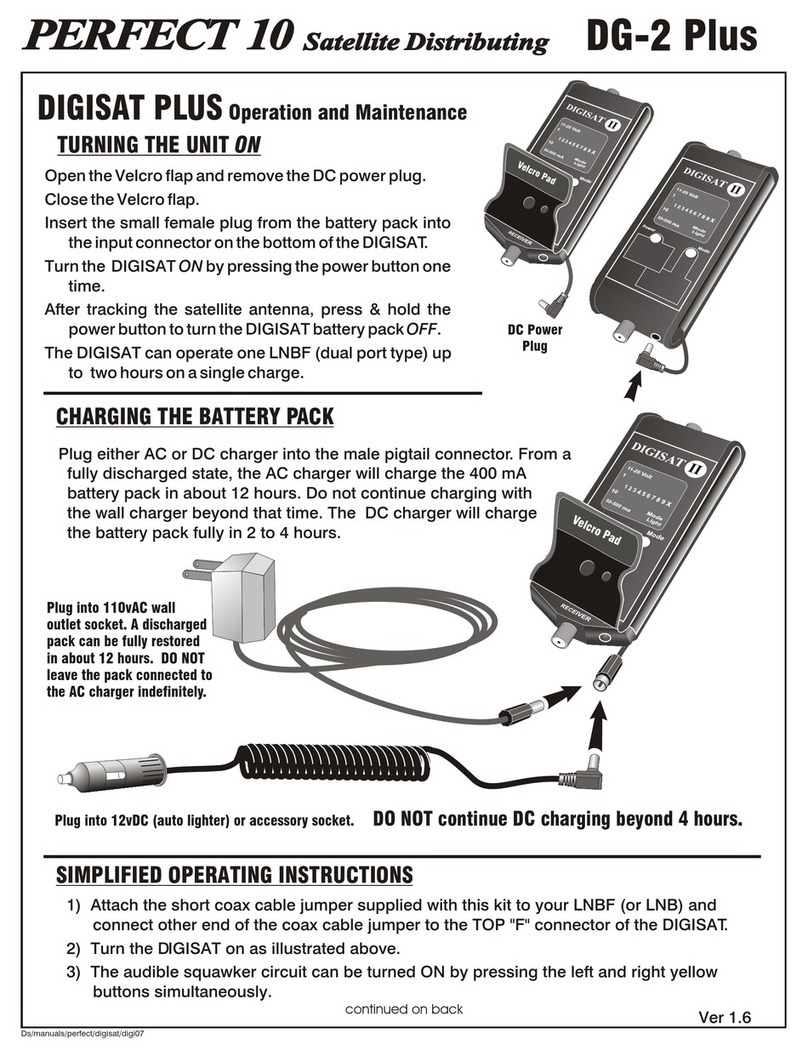
Perfect 10 Satellite Distributing
Perfect 10 Satellite Distributing Digistat DG-2 Plus manual

Dewetron
Dewetron TRIONet Technical reference manual

Tektronix
Tektronix MTS4000 MPEG instructions

Shodex
Shodex OHpak SB-2000 Series Operation manual

Kistler
Kistler 9366CD instruction manual
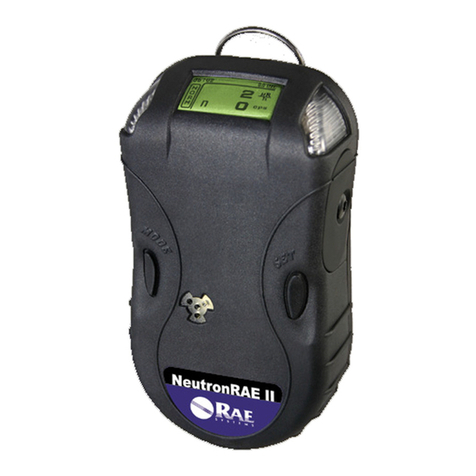
Rae
Rae NeutronRAE II user guide






